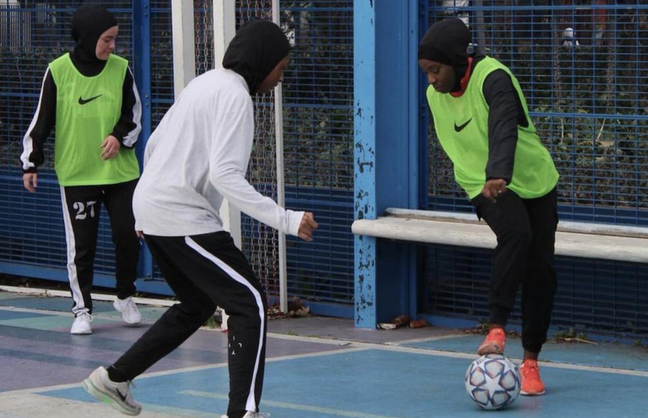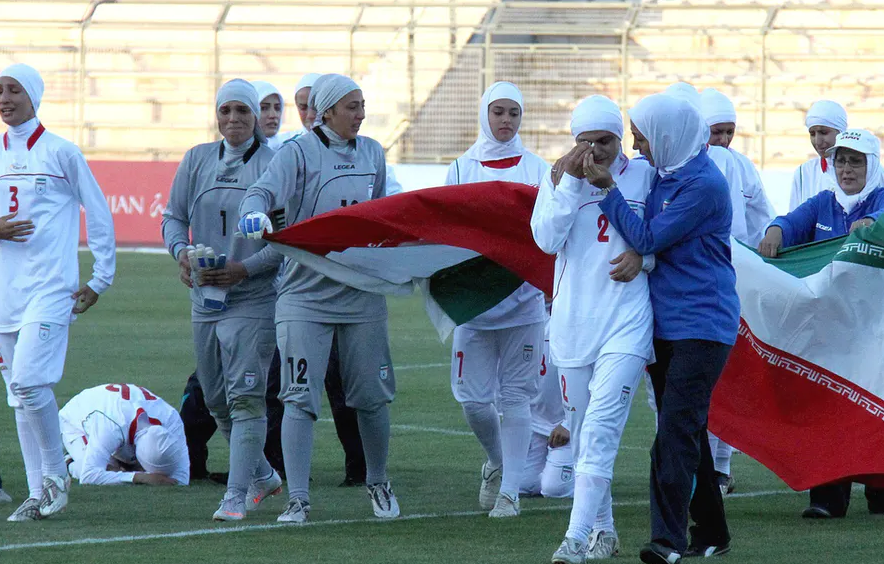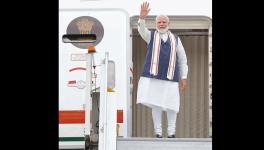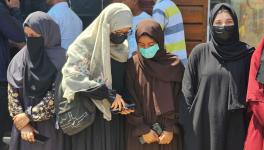Hijabophobia and More: France Playing a Divisive, Discriminative, and Dangerous Game With Ban of Hijab in Sport

Young muslim women playing a pick-up game of football in France. (Pic: @leshijabeuses/Instagram).
It transpired a little over a decade back. But the imagery, the heartbreak it represents, is deeply entrenched in our collective consciousness. We don’t need reminders to tell us what the Iran women’s football team players lost after FIFA forced them to forfeit their London Olympics qualifier match against Jordan in 2011. This was not just about a chance to play in the world’s biggest sporting festival. It was not just about the loss on the playing field, either. Those teary-eyed, hijab-clad women lost that day not by any sporting yardstick or merit in their game. They were, instead, judged, humiliated even, while their hijab-clad personas were pushed into the eye of a storm that has been raging for many years now, and it so seems, will continue its disruptive spree.
The tall claims sport makes — the spirit of fair play and inclusiveness as well as the ‘the beauty’ in football — all fell flat that day. It, perhaps, showed the world that sport is not the monolithic ambit of games but a veritable extension of the societal restrictions and impositions, especially when it comes to women.
We do not need reminders as to who won that day, the fifth day of June 2011. But we do get them, in an eerie, real sense. Very periodically that too. Hijab in sport is once again in the eye of a storm, this time in France, and this time, it is not purely skewed and discriminative sporting logic that has been used while attempting a blanket ban.
It is 2022! The present controversy began with the French Senate voting in favour of banning hijab and other "conspicuous religious symbols" in sports competitions in the country. Let us not forget that post 2011 and the infamous Iranian incident, FIFA and the International Olympic Committee (IOC) lifted restrictions on the use of hijabs during competition. So the French ban lands the country on a collusive plane against its Muslim minority. The values that this ban is meant to serve and uphold — that of secularism and national identity — stand a good chance of being compromised since the question now is how to determine the degree of conspicuousness of this religious symbol. That definition remains both contentious and hypocritical. It is a reality out there, on the playing field, that a Christian cross may not come across as conspicuous even though it is a blatant religious symbol, while a hijab may be ‘conspicuous’. It is not just because of the symbol that it is, but because of the religious association it connotes!
Also Read | No Dream is Too Big for Salima Mukansanga, AFCON's First Woman Referee
The hijab conversation is multi-layered. To start with, let us first address the elephant in the room — the question of identity. The players who are the target here, carry with them a double-edged identity. They are women; they are Muslims too. In short, what is at ‘play’ here is a saga of double-marginalisation — a concoction of gender-based discrimination and Islamophobia. And, when this gender-based discrimination draws fuel from the visible signifier of an Islamic attire, the hijab (or any other type of Islamic veiling for that matter), it is termed as hijabophobia. In other words, it hints at the threat perception emanating from the hijab; the viability of that perception not only is highly dubious, but also engenders the debates on hijab.
The debates on hijab date long back in the French context. While France spearheading the ban is not new, beyond the country, it is emblematic of the worldwide politics of Islamophobia. The debate in France erupted in 1989 when three Muslim girls of North African origin, from the poor and ethnically diverse Parisian suburb of Creil, were debarred from their school for refusing to take their headscarves off. In 2004, with 9/11 fanning a global War on Terror, France had proscribed overt religious symbols in schools on the grounds of it flouting the norms of French secularism. In 2010, the Nicolas Sarkozy government passed a law banning face-veils with Muslim attires. This ban still remains a raging point of contention at any debates surrounding hijabs. It also triggered a cascading effect across Europe at the time.

Inconsolable Iran women’s football team players in 2011 after they were forced to forfeit their Olympic qualifier against Jordan for wearing hijabs (Pic: The Conversation).
Many European countries joined the banning bandwagon in no time. Not just Europe, but countries replicating the European model of the modern state system somewhat co-opted the ban, valorizing the rationale of national security. The same tonality of argument is predominant even in the Indian educational institutions of today.
The numbers, non-partisan as ever, give us a larger understanding of the hypocrisy, or myopia, that was involved in the 2010 ban. Let us note that at the time of the implementation of the ban, out of a total 4.7 million Muslims in France, only 1,900 were using face-veils. This happens to be the official estimate. Now, this begs us to ask a very important question: How much of the threat is a reality, and whether there is a threat at all? The reality is that beyond the political doctrine of secularism, the concept of French ‘secular’ operates as a mediating societal factor and is therefore, circumscribed by crude political variables such as refugee influx, rising anti-immigration sentiments and right-wing parties, across the globe.
The worrying part is that the French ban that was played out in and around educational institutions is spilling over into the hallowed domain of sport.
Also Read | Praful Patel Faces Heat as Football Federation Members Demand Polls
When it comes to international sport, women are caught between the tight-rope of ‘culture’ versus the ‘universal’. It stretches them from both ends of the spectrum and serves to delineate women. The double-edged hijabophobia spirals from both the universalised notions of women’s dress in sports that caters to Western sensibilities, and a few Islamic countries imposing cultural dress codes on players as a rejoinder. Let us not forget that it was only after complying with the state requirement of an outfit with full coverage of the body that Shirin Gerami, the first female Iranian triathlete, obtained her government’s permission to participate in a world championship in 2013. However, it is also true that hijabophobia in the context of sport has more to do with the western standardisation of international sport — both as the parameter and reference point to accomplishments.
The idea of ‘international’ largely caters to the Western sensibilities. So, when it comes to the concept of ‘ideal’ dressing for women in sport, those who cover themselves up during activity to either abide by the state and societal restrictions or follow their own religious convictions, are compelled to stay away from the playing field. The hypocrisy heightens in the frequent suggestions of wearing skimpier clothes during sport, more often than not coming from the top bosses of international governing bodies to boost viewership.
Hijabi women are barred from the playing ground, invoking either the remarkable visibility of the religious symbol contravening secularism or concerns over women’s safety and comfort. The argument regarding religious symbols holds no ground because male players making religious gestures or playing with overt symbols like tattoos and crosses are not unusual sights in big sport. While the practical concerns regarding safety may have some merits in specific sports like wrestling where there are chances of being grabbed by the neck, for most of the sports, hijab creates no hindrance at all. After all, if a woman player makes the choice to play with their hijabs on or off, why should there be any imposition made by any external authority? Though the decisions of permitting women in hijabs during international sports events somewhat legitimises the state/societal impositions, foiling the sporting aspirations of women through strict standardisation of dress codes inadvertently contributes to curbing women’s agency.
Also Read | Shanti Mullick: A Mystical Passer in a Physical World
In short, be it France or FIFA, be it India or Iran, be it Canada or Karnataka, even be it education, the arts or sports — cutting across geography and societal compartmentalization — hijabophobia shackles Muslim women’s dreams, clips their wings, and deny them the right to a dignified life. An escalated hijab row from the 1990s not only cuts across the decades and borders in a persistent manner, but also impinges upon a version of secularism bereft of the values of liberal democratic tolerance. It is undemocratic so far as it lends the onus of assimilation solely on the ‘other’ and creates the phantom of terrorism out of an article of clothing.
Overall, hijabophobia comprises two sides of the same coin. It swings itself between forced unveiling and forced veiling of Muslim women. While the former historically reeks in the colonial morality of exoticisation and male saviour complex, the latter is rather reactionary. Nonetheless women, their present and future, are caught in between as the tug of war continues over controlling their bodies. At the end, it robs women of their choice; a version of ‘choice’ that is away from the liberal illusion of democratic rights and is rather constricted in its interplay with society.
(The author is Assistant Professor at JAIN (deemed-to-be) University, and specialises in the study of gender and culture vis-à-vis international politics)
Get the latest reports & analysis with people's perspective on Protests, movements & deep analytical videos, discussions of the current affairs in your Telegram app. Subscribe to NewsClick's Telegram channel & get Real-Time updates on stories, as they get published on our website.
























